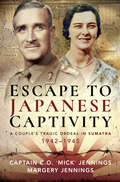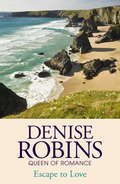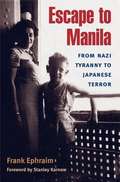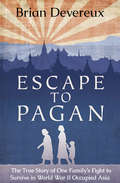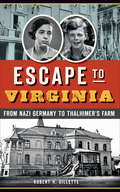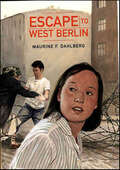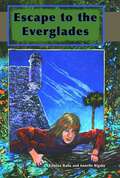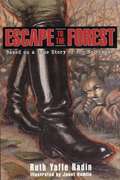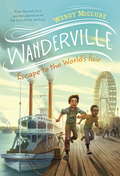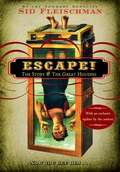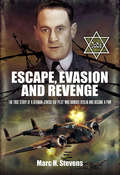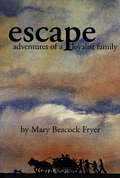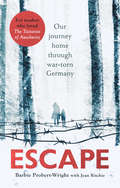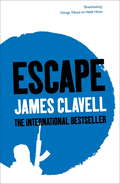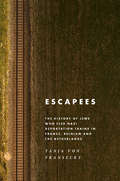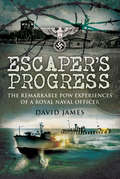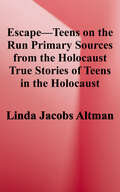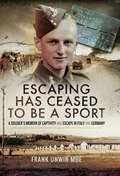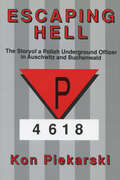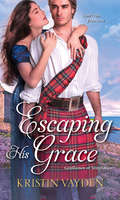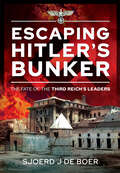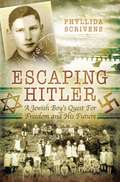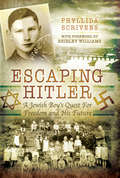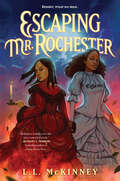- Table View
- List View
Escape to Japanese Captivity: A Couple's Tragic Ordeal in Sumatra, 1942–1945
by Captain C.O. Mick Jennings Margery JenningsThis harrowing WWII memoir recounts the tragic ordeal of a British couple separated by war and taken prisoner by Japanese forces in Sumatra.Captain C.O. “Mick” Jennings and his wife Margery were living in British Singapore when the Japanese invaded in 1941. Margery was on her way to Australia with other British families when their ship was bombed, leading to her capture in Sumatra. When Singapore fell in February 1942, Mick and other soldiers commandeered a junk and sailed to Sumatra. With a fellow soldier, he set sail for Australia in a seventeen-foot dinghy. But after an appalling ordeal at sea, he was also captured.Despite their close proximity, Mick and Margery never saw each other again. Though they managed to exchange a few letters, Margery died of deprivation and exhaustion in May 1945, shortly before VJ day, while Mick miraculously survived.Based on personal accounts and Margery’s secret diary, this outstanding book describes in graphic detail their attempted escapes and horrific imprisonments. Above all it is a moving testimony to the couple’s courage, resilience, and ingenuity.
Escape to Love
by Denise RobinsStorm Castle - home of the Trevarwiths - on the wild Cornish coast. A bride and bridegroom driving up to the doors...a white-faced child peering from a turret window... the first dread meeting between the bride and her red-haired vixen of a step-mother...In later years, after the death of Celia Trevarwith's father, during the Second World War, Paul Manton comes to the district. A Free-French fisherman; he falls madly in love with Celia. She then embarks on a passionate struggle for her love and happiness with Paul, always up against her step-mother's opposition.
Escape to Love
by Denise RobinsStorm Castle - home of the Trevarwiths - on the wild Cornish coast. A bride and bridegroom driving up to the doors...a white-faced child peering from a turret window... the first dread meeting between the bride and her red-haired vixen of a step-mother...In later years, after the death of Celia Trevarwith's father, during the Second World War, Paul Manton comes to the district. A Free-French fisherman; he falls madly in love with Celia. She then embarks on a passionate struggle for her love and happiness with Paul, always up against her step-mother's opposition.
Escape to Manila: From Nazi Tyranny to Japanese Terror
by Frank EphraimWith the rise of Nazism in the 1930s more than a thousand European Jews sought refuge in the Philippines, joining the small Jewish population of Manila. When the Japanese invaded the islands in 1941, the peaceful existence of the barely settled Jews filled with the kinds of uncertainties and oppression they thought they had left behind. Escape to Manila gathers the testimonies of thirty-six refugees, who describe the difficult journey to Manila, the lives they built there, and the events surrounding the Japanese invasion. Combining these accounts with historical and archival records, Manila newspapers, and U.S. government documents, Frank Ephraim constructs a detailed account of this little-known chapter of world history.
Escape to Pagan: The True Story of One Family's Fight to Survive in World War II Occupied Asia
by Brian DevereuxThe true story of a soldier who survived Japanese capture, a sinking hell ship, and the bombing of Nagasaki, all while his family fought their own battle in the Burmese jungle. While leading an attack on Hong Kong&’s Golden Hill, Jack Devereux of the Royal Scots is shot through the head. Then a Japanese officer attempts to behead him in order to blood his samurai sword. Waking briefly, Devereux kills his would-be executioner, impressing his captors. Fascinated by their prisoner&’s grisly wounds, they allow him to live, but Devereux&’s trials are only beginning. In a precarious physical state, the wounded soldier experiences the horrific sinking of the Japanese freighter LisbonMaru, in which hundreds of POWs drown; survives the shark-infested South China Sea; and burrows in the mines of Nagasaki as the atom bomb falls. Meanwhile, his family hides in Burma, hoping against hope that they will one day be reunited with Devereux. Written by his son, Brian Devereux—whose mother carried him from Mandalay to the deserted medieval city known today as Bagan—this is an amazing account of the terrifying wartime journey of a soldier and his family.
Escape to Virginia: From Nazi Germany to Thalhimer's Farm
by Robert H. Gillette&“Fascinating . . . Provides a history of the Holocaust as the tapestry against which the trials and adventures of these young Jewish youth played out&” (Jewish Book Council). Jewish teenagers Eva and Töpper were desperately searching for an escape from the stranglehold of 1930s Nazi Germany. They studied agriculture at the Gross Breesen Institute in hopes of securing visas to gain freedom from the tyranny around them. Then, Richmond department store owner William B. Thalhimer created a safe haven on a rural Virginia farm where Eva and Töpper would find refuge. Discover the remarkable true story of two young German Jews who endured the emotional torture of their adolescence, journeyed to freedom, and ultimately confronted the evil that could not destroy their spirit. Author Robert H. Gillette retells this harrowing narrative that is sure to inspire generations to come. Includes photos! &“Escape to Virginia is not only an illuminating history lesson, bridging the Old World and the New World during its most tumultuous period, it is also an exemplary story on various levels and for readers of all ages, crystallizing time and again the Gross Breesen spirit of hope, courage and resilience. The book is well researched, vividly narrated, and richly illustrated.&” —Jewish New
Escape to West Berlin
by Maurine F. DahlbergThe advent of the WallHeidi's thirteenth birthday is coming up, but she's disappointed -- her mother is pregnant and refuses to make the annual summer visit to Heidi's grandmother. What's more, it's 1961 and the government is cracking down on border crossers, people who work in the West but live in the East. Heidi's father is a border crosser, and her best friend, Petra, has been forbidden to see Heidi until her father finds a new job in East Berlin. Heidi feels betrayed. Then, as political tension mounts, her parents tell her they are secretly moving West, and Heidi must travel alone to get her grandmother. But how can she do it without Petra's help?The author captures all the terror of the time in her gripping story of an indomitable heroine who steals across the Berlin border by facing her greatest fear.
Escape to the Everglades (Florida Historical Fiction for Youth)
by Edwina Raffa Annelle RigsbyRunning Boy of the Snake Clan of the Seminoles has lived with his uncle in the Everglades since his mother, a Seminole, and his father, a white man, were taken by the Breath Maker. Now he is fourteen and has received his adult name, Will Cypress, at the annual Green Corn Dance. In the eyes of his tribe Will is now a man, and he is eager to prove his courage as a warrior against the U.S. Army in the Second Seminole War. Will's manhood is accepted by all the Seminoles except Tiger, a bully who has always hated Will because of his white blood and superior running and hunting skills. Hoping to convince Tiger of his loyalty to the Snake Clan, Will sets out to join Osceola's band of warriors who are fighting to remain in Florida. On his way to the war chief's camp, Will stumbles upon a family secret that makes the battle for his homeland a personal one. He never loses his will to overcome, even when the whites break their truce and capture the Seminoles and imprison them in the fort in St. Augustine. Will faces the daunting challenge of honoring his heritage while desperately struggling to hold on to his dream. Valuable lessons about friendship, perseverance, and the power of the truth.Next in series > >See all of the books in this series
Escape to the Forest
by Ruth Yaffe RadinWhen the Nazis invade Poland, nothing is safe anymore. Ten-year-old Sarah and her family must leave their home and live in a Jewish ghetto surrounded by barbed wire. There, life is a nightmare of cold and hunger where Nazi soldiers kill Jews at will. But Sarah still hears stories that give her hope-stories about a man who lives in the nearby forest, fighting the Nazis and sheltering other Jews, Sarah's brother thinks they should try to escape to the forest. Her parents think they will be safer where they are, Sarah doesn't know who is right. But as life in the ghetto grows worse and worse, the forest may be their only hope. Based on a true story of life during the Holocaust, this is a heartrending novel of one family's struggle to survive.
Escape to the World's Fair
by Wendy McclureCatch a ferry to the 1904 World's Fair with the orphans of Wanderville! The orphans of Wanderville have decided to never again let themselves be confused by adults offering them shiny red apples and warm beds. They're going to make their way to California and establish a more permanent spot for Wanderville.But when they're suddenly left without means of transportation, the orphans must find a new way of getting to their "town." Enter a dandy motorist with a proposition: If the orphans agree to take a mysterious artifact to the 1904 St. Louis World's Fair on his behalf, they will receive a handsome reward that will allow them to book passage west.The citizens of Wanderville conclude that this is their best bet. What they don't realize, however, is just how treacherous the journey to the fair will be and how much they will need to sacrifice to finally find themselves a new home.
Escape! The Story of the Great Houdini
by Sid FleischmanBiography of Houdini. How did he walk through walls, escape drowning, and shatter iron chains? The rare photos and the exclusive update about the rumor that Houdini was poisoned might help. But remember, a true magician never reveals his tricks.
Escape, Evasion and Revenge: The True Story of a German-Jewish RAF Pilot Who Bombed Berlin and Became a PoW
by Marc H. Stevens&“A truly remarkable story . . . Marc Stevens has produced a fitting tribute to his father . . . who played a full part in the defeat of Nazi Germany.&” —HistoryOfWar.org Peter Stevens was a German-Jewish refugee who escaped Nazi persecution as a teenager in 1933. He joined the RAF in 1939 and after eighteen months of pilot training he started flying bombing missions against his own country. He completed twenty-two missions before being shot down and taken prisoner by the Nazis in September 1941. To escape became his raison d&’être and his great advantage was that he was in his native country. He was recaptured after each of his several escapes, but the Nazis never realized his true identity. He took part in the logistics and planning of several major breakouts, including The Great Escape, but was never successful in getting back to England. After liberation, when the true nature of his exploits came to light, he was awarded the Military Cross. He then served as a British spy at the beginning of the Cold War before emigrating to Canada to resume a normal life. This is the story of a heavily conflicted young man, alone in a world that is in the midst of destruction. He is afforded an opportunity to help his persecuted people to obtain a small measure of revenge. It is at once a sad yet uplifting tale of thankless and unheralded heroism.&“This is a wartime career that would make any son proud, but Steven&’s real triumph is in writing a biography that will satisfy the most discerning historian.&” —National Defence Journal
Escape: Adventures of a Loyalist Family
by Mary Beacock FryerPlots, shots, flight, pursuit — all are part of this story from the exciting chapter in America’s history when thousands of Loyalists fled to Canada to evade the vengeance of the American Revolutionaries. Twelve-year-old Ned Seaman tells this lively tale of his family’s perilous journey. Escape may be fiction, but Martha and Caleb Seaman and their children actually existed.
Escape: Our journey home through war-torn Germany
by Barbie Probert-WrightTwo sisters.One extraordinary true story.Germany, 1945. Trapped between advancing armies, stranded hundreds of miles from their mother, and with their father missing in action, sisters Barbie and Eva were confronted with an impossible choice.Should they stay and face invasion or risk their lives to find their mother?Together, they set out on a perilous three-hundred mile journey on foot across a country ravaged by war. Fuelled by courage and love, Eva and seven-year-old Barbie encounter incredible hardship, extraordinary bravery, and overwhelming generosity.Against all odds, they both survived.But neither sister came out of the journey unscathed . . .This is the powerful true story of their escape.(Previously published as Little Girl Lost)
Escape: The Love Story from Whirlwind
by James ClavellThe Shah is thrown out of Iran and the nation's turmoil becomes world headlines. Caught in this shifting world of fanaticism, ambition, duplicity, heartbreak and violent death are the foreign helicopter pilots who have been servicing the oilfields up and down the country. Their one objective now is to make a bold concerted escape, with their helicopters, to safety across the Gulf. But one of the pilots, Erikki, the blond Finnish pilot, is married to a beautiful high-born Iranian wife, Azadeh, and this story is about what happens to them.
Escapees: The History of Jews Who Fled Nazi Deportation Trains in France, Belgium, and the Netherlands
by Tanja Von FranseckyOf the countless stories of resistance, ingenuity, and personal risk to emerge in the years following the Holocaust, among the most remarkable, yet largely overlooked, are those of the hundreds of Jewish deportees who escaped from moving trains bound for the extermination camps. In France, Belgium, and the Netherlands alone over 750 men, women and children undertook such dramatic escape attempts, despite the extraordinary uncertainty and physical danger they often faced. Drawing upon extensive interviews and a wealth of new historical evidence, Escapees gives a fascinating collective account of this hitherto neglected form of resistance to Nazi persecution.
Escaper’s Progress: The Remarkable POW Experiences of a Royal Naval Officer
by David JamesDavid James was in Motor Gunboats (with Robert Hichens of Gunboat Command.) Captured in February 1943 after abandoning ship as a result of a fierce engagement with three German armed trawlers in the North Sea he was imprisoned in Dulag Marlag.His first tunnel was discovered before completion. In December 1943 he succeeded in escaping during the weekly bath house visit and was on the run for almost a week disguised as an officer of the Royal Bulgarian Navy. He was captured after several close calls while attempting to board a ship at Lubeck.In February 1944 he escaped again this time dressed as a Swedish sailor and traveled by train to Bremen, Hamburg, Lubeck, Rostock finishing up in Danzig, all the while searching for a suitable ship. He eventually succeeded in reaching Stockholm after 2 days in the extreme heat of a ships engine room. His superbly written narrative is full of suspense and excitement.
Escape—Teens on the Run: Primary Sources From the Holocaust (True Stories of Teens in the Holocaust Series)
by Linda Jacobs Altman"Discusses children and teens on the run during the Holocaust in Europe, including the different ways young people escaped the Nazis, places of refuge in Europe, and hiding and resistance."- Provided by publisher
Escaping Has Ceased to Be a Sport: A Soldier's Memoir of Captivity and Escape in Italy and Germany
by Frank UnwinAfter being taken prisoner at Tobruk and transported to Italy, the author was determined to escape and learnt Italian by talking to the sentries. His first escape lasted just one week. He then joined a tunnel party and escaped again. After six weeks on the run he was offered shelter in a Tuscan hilltop village, Montebenichi. There he enjoyed five months of freedom, living the lifestyle and ancient customs of these peasant people.While attempting to re-join the Allied armies, Frank and two fellow POWs were re-captured and sent to a brutal work camp in Germany. His defiant attitude exacerbated an already difficult situation. In March 1945, with the Allies closing in Frank took part in The Long March, walking for several weeks before being released by American troops. The title of this remarkable and moving memoir results from a notice posted to Franks amusement in all POW camps saying Escaping has ceased to be a Sport.' This is an exceptional Second World War POW account by a man who refused to accept captivity.
Escaping Hell: The story of a Polish underground officer in Auschwitz and Buchenwald
by Kon PierkarskiEscaping Hell is the compelling and true story of a heroic young Polish officer who survived the terror of five years in the prisons of Auschwitz and Buchenwald – where violence was meaningless because human life had lost all value. During World War II, Kon Piekarski was a member of the Polish Underground Army, a clandestine resistance movement which operated even inside Auschwitz – organizing spectacular escapes, operating a secret radio network and matching wits with the Gestapo. After Auschwitz, Piekarski became a prisoner of war at Buchenwald and spent time working in a factory where Russian prisoners of war were used for labour. In the face of constant danger, he and his comrades took every possible opportunity to sabotage the German war industry. He was finally transferred to a small camp near the French border, and escaped three months before the end of the war.
Escaping His Grace (Gentlemen of Temptation #2)
by Kristin VaydenTo escape her father's marriage match, a lady flees to Scotland—where her false identity leads to true love in this steamy Regency romance.Lady Samantha Chatterworth will do anything to avoid being forced into a loveless marriage by her tyrannical duke of a father. That would explain why she's in Edinburgh, Scotland, calling herself Miss Miranda. She soon finds safety working in the household of the unsuspecting—and irresistible—Heathcliff Marston, Viscount Kilpatrick.Between the gentlemen's club he runs and his newly acquired ward, Heathcliff has enough to worry about without investigators hounding him about some duke's runaway daughter. At least he's secured a governess—no doubt a sour woman. Or so he expects, until he meets intriguing Miranda. Certainly, a peer of the realm would never entertain a dalliance with the help . . . but this is no ordinary dalliance, and the Viscount is no ordinary peer of the realm . . .
Escaping Hitler's Bunker: The Fate of the Third Reich's Leaders
by Sjoerd J. de BoerAs the Soviet troops fought their way ever closer to the Reich Chancellery in the final days of the Third Reich, deep underground in Hitler’s bunker fateful decisions were being made. Hitler and some of those closest to him resolved to commit suicide, whilst others sought to try and escape. But who did manage to slip past the Russian soldiers and reach freedom? How did they escape, and what routes did they take through the ruined streets of Berlin? Equally, what became of those who escaped, where did they go, and what happened to those who did not get away? All of these questions are answered in this book. Following years of research in Berlin, the author has been able to identify the various groups and individuals that left the bunker and has traced the paths taken by those who escaped and those that perished. The final days in Hitler’s bunker are revealed in atmospheric detail, as the Red Army closed in and the inevitable end loomed menacingly nearer with the passing of every hour. Many notable persons, such as Bormann, Speer, Göring and Hanna Reitsch, went to say a last farewell to the Führer, while others, such as Goebbels, prepared themselves for suicide rather than being taken prisoner by the Russians. By using detailed maps showing the escape routes, first-hand testimony from those who survived, photographs of the devastated German capital in 1945, as well as images of the various routes as they can be followed through Berlin today, the author explores the last moments of the Third Reich in startling clarity.
Escaping Hitler: A Jewish Boy's Quest for Freedom and His Future
by Phyllida ScrivensThe story of a young boy who escaped Hitler and the Holocaust-and lived happily ever after.Escaping Hitler is the true story, covering ninety years, of Günter Stern who, at fourteen, when Adolf Hitler threatened his family, education, and future, resolved to escape from his rural village of Nickenich in the German Rhineland. In July 1939, Günter boarded a bus to the border of Luxembourg, illegally crossed the river, and walked alone for seven days through Belgium and into Holland. He was intent on catching a ferry to England and freedom, but the outcome of his journey was not exactly as he had planned.Scrivens gathered her information through interviews with Günter, now known as Joe Stirling, and with those closest to him. During an emotional 'foot-stepping’ journey in September 2013, Scrivens also visited Günter’s birthplace, met with a school friend, discovered the apartment in Koblenz where he fled following Kristallnacht in 1938, drove the route of Günter’s walk through Europe, and retraced the final steps of his parents prior to their deportation to a Nazi death camp in Poland during 1942.Skyhorse Publishing, along with our Arcade, Good Books, Sports Publishing, and Yucca imprints, is proud to publish a broad range of biographies, autobiographies, and memoirs. Our list includes biographies on well-known historical figures like Benjamin Franklin, Nelson Mandela, and Alexander Graham Bell, as well as villains from history, such as Heinrich Himmler, John Wayne Gacy, and O. J. Simpson. We have also published survivor stories of World War II, memoirs about overcoming adversity, first-hand tales of adventure, and much more. While not every title we publish becomes a New York Times bestseller or a national bestseller, we are committed to books on subjects that are sometimes overlooked and to authors whose work might not otherwise find a home.
Escaping Hitler: A Jewish Boy's Quest for Freedom and His Future
by Phyllida ScrivensEscaping Hitler is the true story, covering ninety years, of a fourteen-year-old boy Gnter Stern who, when Adolf Hitler threatened his family, education and future, resolved to escape from his rural village of Nickenich in the German Rhineland. In July 1939 Gnter boarded a bus to the border with Luxembourg, illegally crossed the river and walked alone for seven days through Belgium into Holland, intent on catching a ferry to England and freedom. The outcome was not exactly as he had planned. The author gathered her information through interviews with Gnter, now known as Joe Stirling, and with those closest to him. During an emotional foot-stepping journey in September 2013 the author visited Gnters birthplace, met with a school friend, discovered the apartment in Koblenz where he fled following Kristallnacht in 1938, drove the route of Gnters walk through Europe and retraced the final steps of his parents prior to their deportation to a Nazi death camp in Poland during 1942.
Escaping Mr. Rochester
by L.L. McKinneyIn this fresh reimagining of Charlotte Brontë’s classic novel by acclaimed author L. L. McKinney, Jane Eyre and Bertha Mason must save each other from the horrifying machinations of Mr. Rochester in this intrigue-filled, empowering young adult romance. Jane Eyre has no interest in a husband. Eager to make her own way in the world, she accepts the governess position at Thornfield Hall.Though her new employer, Edward Rochester, has a charming air—not to mention a handsome face—Jane discovers that his smile can sharpen in an instant. Plagued by Edward’s mercurial mood and the strange wails that echo through the corridors, Jane grows suspicious of the secrets hidden within Thornfield Hall—unaware of the true horrors lurking above her very head.On the topmost floor, Bertha Mason is trapped in more ways than one. After her whirlwind marriage to Edward turned into a nightmare, he locked her away as revenge for withholding her inheritance. Now his patience grows thin in the face of Bertha’s resilience and Jane’s persistent questions, and both young women are in more danger than they realize.When their only chance at safety—and perhaps something more—is in each other’s arms, can they find and keep one another safe before Edward’s dark machinations close in around them?
